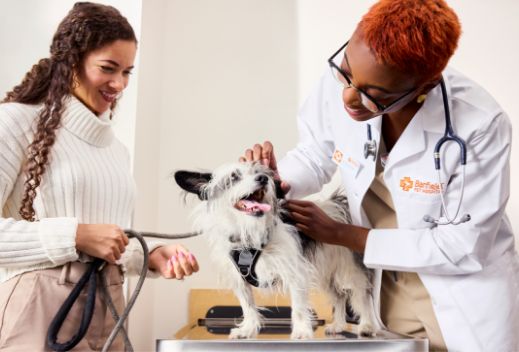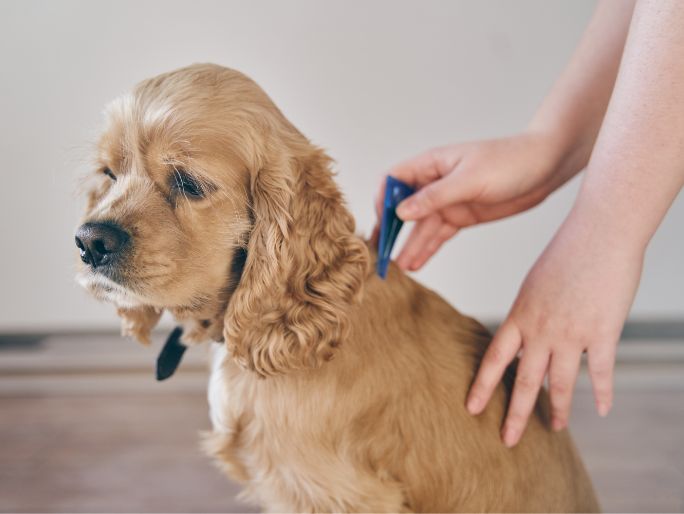symptoms of parasites in dogs
From fleas and ticks to worms, heartworm, ear mites, mange, and single-celled stomach bugs, here’s what to watch for and how to help your pup.
See your veterinary team as soon as possible if you suspect your puppy or dog has any kind of parasite. We can help with treatment and prevention, plus give you the information you need to help prevent infecting people and other pets.

Select symptoms of parasites in dogs
- Vomiting and/or diarrhea
- Weight loss
- Worms in poop or vomit
- Visible fleas or “flea dirt”
- Dull hair coat
- Swollen belly
- Skin sores or bald patches from scratching
- Labored breathing
- Decreased appetite
- General ill health

How to help treat and prevent parasites in pets
- See your veterinary team ASAP
- Avoid home or “natural” remedies
- Year-round parasite prevention
- Good home hygiene and care
Symptoms of worms, fleas and ticks, external parasites, and more in dogs
Parasites in dogs include intestinal worms, heartworm disease, fleas and ticks, mites, and single-celled gastrointestinal bugs. Reach out if you have concerns — your veterinary team is here to help.

Signs of worms, roundworms, and tapeworms: Are there worms in your dog’s poop or vomit?
Internal parasites like tapeworms, hookworms, whipworms, and roundworms take up residence inside your dog’s intestinal system to steal blood and nutrients. This can present itself as diarrhea, weight loss, and/or visible worms in your pup’s poop. A serious infestation can sicken and even kill vulnerable dogs due to inflammation and blood loss.
Many parasitic worms can also infect humans. Here’s how it happens: The worms’ microscopic eggs are passed from furry friend to human hand and then accidentally to human mouth. Always wash your hands thoroughly after touching your dog or picking up their poop, even if your dog has no symptoms. See more about worms in dogs
Signs of heartworm disease: Is your dog lethargic, coughing, and losing weight?
Heartworm, or Dirofilaria immitis, is a parasitic worm that lives in the heart, lungs, and associated blood vessels. Even a small infestation can interfere with normal heart function, while an untreated infestation can cause long-term organ damage and death.
Heartworms continue to grow and can block the flow of blood. Dogs may be reluctant to eat or exercise. Their lungs can be affected, causing labored breathing and a cough. See more about heartworm
Signs of Giardia and other stomach bugs: Does your dog have diarrhea and weight loss?
Single-celled gastrointestinal parasites like Giardia and coccidia can cause life-threatening watery or bloody diarrhea, vomiting, weight loss, and general ill health in dogs. Please seek immediate veterinary care — an untreated single-celled parasite infection isn’t just dangerous for your dog; it can also spread to other pets and people. See more about single-celled parasites
How to tell if your dog has fleas or ticks: Is your dog always scratching? Did you find a tick on your dog?
Worms are internal parasites, while external parasites in dogs include fleas and ticks. Your veterinary team can suggest a number of different solutions to prevent and treat fleas and ticks. We can also talk to you about managing the risks from parasite-carried infection, like Lyme disease from ticks.

Signs of ear mites: Is your dog scratching their ear? Do you see black or brown “coffee grounds” in their ear canal?
Both cats and dogs can develop itchy infestations of tiny, spider-like ear mites inside their ears. Look for dry or greasy brown or black gunk, as well as signs like head shaking, pawing or scratching their ears, and dragging their ears over furniture or on the ground.
Dogs with ear symptoms should see the vet. It’s very important not to self-diagnose or self-treat ear issues to avoid making matters worse for your pet. See more about ear mites
Clinical signs of mites and other skin parasites: Does your dog have bald, rough red patches on their skin?In addition to fleas and ticks, dogs can develop other issues with parasites like mites, fungus, and even maggots. Treating these issues promptly can help your pet be more comfortable and prevent secondary infections. Please reach out to your veterinary team. See more about mites and other skin parasites

An Optimum Wellness Plan is a smart way to prevent pests
Our Optimum Wellness Plans® are affordable yearlong packages of essential preventive care. They're designed for different needs, ages, and lifestyles, and include options to easily add parasite control for fleas, ticks, and more.
Talk to your Banfield vet to find out which package is best for your pet.
Mentioned in this article

Does your dog have worms?
Puppies and adult dogs are at risk.

Why is my pet so itchy?
Scratching can mean fleas, allergies, or infections.

All about fleas and dogs
Tiny insects. Big threat.

Ticks are trouble for dogs
Here’s how to prevent and treat them.

Banfield’s guide to skin rashes
Causes and symptoms of skin rashes.

Worried about your pet? Ping Pet Chat™!
Whether it's 3 a.m. or 3 p.m., connect with a real veterinary professional for immediate petcare advice. It's included in all Optimum Wellness Plans®!
Log in to start chatting
Parasites on the prowl
20% OFF select parasite control meds or 25% OFF any new AutoShip. Use code BUZZOFF. Max $25 off. Terms apply.
Banfield can help prevent and treat parasites in pets
Regular wellness exams that include a full physical and fecal exam can help keep your furball happy and healthy. Kittens and puppies should start regular appointments when they’re about 6 weeks old, and then come in twice a year once they’re 5 months old. At your visits, we’ll check your little love from nose to tail, discuss age, needs, and lifestyle, and recommend trusted prevention medication to help fight off nasty critters that might feed on your pet.

Even if your pet is on a regular preventive for fleas, ticks, worms, mange, and other bugs, please make an appointment as soon as possible if you spot potential symptoms. Sooner is always better in helping to prevent a big infestation for your furry friend.
 Mites and mange
Mites and mange Podcast - Not Just Fluff
Podcast - Not Just Fluff



